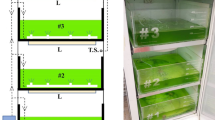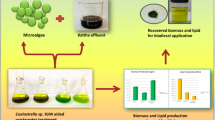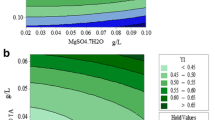Abstract
Microalgae are used as a third-generation biofuel feedstock to overcome the problems, of first- and second-generation feedstocks, such as food versus fuel competition and longer harvesting time. However, the use of microalgae as a feedstock for biodiesel production is limited by the lipid content in the biomass. The development of strategies to enhance both the biomass and lipid content would lead to low-cost processes for biofuel production. In the present study, NaNO3, K2HPO4, NaCl, and initial medium pH were optimized to enhance both biomass yield and lipid content of freshwater microalgae Scenedesmus obliquus NCIM 5586 in a 5-L open pond system under light and dark period using central composite design. A multiobjective optimization method is employed to find the tradeoff between biomass and lipid accumulation and to predict the optimum composition for the multiple responses. The maximized yield of biomass and lipid was observed when concentrations of NaNO3, K2HPO4, and NaCl were 1.60 μM, 178.38 μM, and 24.80 mM, respectively, with initial medium pH of 7.23. The final yields of biomass and lipid at optimized conditions were recorded to be 1275.8 mg/L/day and 50.66% dcw, respectively. The obtained results indicate the significance of Scenedesmus obliquus cultivation in the open pond for the generation of feedstock for 3G biofuels.






Similar content being viewed by others
References
Panwar N, Kaushik S, Kothari S (2011) Role of renewable energy sources in environmental protection: a review. Renewable sustainable energy reviews 15(3):1513–1524
Harish B, Ramaiah MJ, Uppuluri KB (2015) Bioengineering strategies on catalysis for the effective production of renewable and sustainable energy. Renewable sustainable energy reviews 51:533–547
Doshi A, Pascoe S, Coglan L, Rainey TJ (2016) Economic and policy issues in the production of algae-based biofuels: a review. Renew Sust Energ Rev 64:329–337
Juneja A, Ceballos RM, Murthy GS (2013) Effects of environmental factors and nutrient availability on the biochemical composition of algae for biofuels production: a review. Energies 6(9):4607–4638
Khan MI, Shin JH, Kim JDJ (2018) The promising future of microalgae: current status, challenges, and optimization of a sustainable and renewable industry for biofuels, feed, and other products. Microb Cell Factories 17(1):36
Lim DK, Garg S, Timmins M, Zhang ES, Thomas-Hall SR, Schuhmann H, Li Y, Schenk PM (2012) Isolation and evaluation of oil-producing microalgae from subtropical coastal and brackish waters. PLoS One 7(7):e40751
Prajapati SK, Malik A, Vijay VK (2014) Comparative evaluation of biomass production and bioenergy generation potential of Chlorella spp. through anaerobic digestion. Appl Energy 114:790–797
Pandey A, Srivastava S, Kumar S (2020) Development and cost-benefit analysis of a novel process for biofuel production from microalgae using pre-treated high-strength fresh cheese whey wastewater. Environmental Science and Pollution Research:1–18
Sánchez-García D, Resendiz-Isidro A, Villegas-Garrido TL, Flores-Ortiz CM, Chávez-Gómez B, Cristiani-Urbina E (2013) Effect of nitrate on lipid production by T. suecica, M. contortum, and C. minutissima. Central European Journal of Biology 8(6):578–590
Wang X-X, Zhang T-Y, Dao G-H, Hu H-Y (2018) Tolerance and resistance characteristics of microalgae Scenedesmus sp. LX1 to methylisothiazolinone. Environ Pollut 241:200–211
Tang D, Han W, Li P, Miao X, Zhong J (2011) CO2 biofixation and fatty acid composition of Scenedesmus obliquus and Chlorella pyrenoidosa in response to different CO2 levels. Bioresour Technol 102(3):3071–3076
Aratboni HA, Rafiei N, Garcia-Granados R, Alemzadeh A, Morones-Ramírez JR (2019) Biomass and lipid induction strategies in microalgae for biofuel production and other applications. Microb Cell Factories 18(1):178
Procházková G, Brányiková I, Zachleder V, Brányik T (2014) Effect of nutrient supply status on biomass composition of eukaryotic green microalgae. J Appl Phycol 26(3):1359–1377
Samkhaniyani F, Najafpour GD, Ardestani F (2017) Evaluation of effective nutritional parameters for Scenedesmus sp. microalgae culturing in a photobioreactor for biodiesel production. Int J Environ Sci Technol 14(5):1037–1046
Anand J, Arumugam M (2015) Enhanced lipid accumulation and biomass yield of Scenedesmus quadricauda under nitrogen starved condition. Bioresour Technol 188:190–194
Kanaga K, Pandey A, Kumar S (2016) Multi-objective optimization of media nutrients for enhanced production of algae biomass and fatty acid biosynthesis from Chlorella pyrenoidosa NCIM 2738. Bioresour Technol 200:940–950
Skorupskaite V, Makareviciene V, Levisauskas D (2015) Optimization of mixotrophic cultivation of microalgae Chlorella sp. for biofuel production using response surface methodology. Algal Res 7:45–50
Kirrolia A, Bishnoi NR, Singh R (2014) Response surface methodology as a decision-making tool for optimization of culture conditions of green microalgae Chlorella spp. for biodiesel production. Ann Microbiol 64(3):1133–1147
Yang F, Long L, Sun X, Wu H, Li T, Xiang W (2014) Optimization of medium using response surface methodology for lipid production by Scenedesmus sp. Marine Drugs 12(3):1245–1257
Jampala P, Tadikamalla S, Preethi M, Ramanujam S, Uppuluri KB (2017) Concurrent production of cellulase and xylanase from Trichoderma reesei NCIM 1186: enhancement of production by desirability-based multi-objective method. 3 Biotech 7 (1):14
Pandey A, Gupta A, Sunny A, Kumar S, Srivastava S (2020) Multi-objective optimization of media components for improved algae biomass, fatty acid and starch biosynthesis from Scenedesmus sp. ASK22 using desirability function approach. Renew Energy 150:476–486
Cheirsilp B, Torpee S (2012) Enhanced growth and lipid production of microalgae under mixotrophic culture condition: effect of light intensity, glucose concentration and fed-batch cultivation. Bioresour Technol 110:510–516
Feng P, Yang K, Xu Z, Wang Z, Fan L, Qin L, Zhu S, Shang C, Chai P, Yuan Z (2014) Growth and lipid accumulation characteristics of Scenedesmus obliquus in semi-continuous cultivation outdoors for biodiesel feedstock production. Bioresour Technol 173:406–414
Barbera E, Sforza E, Kumar S, Morosinotto T, Bertucco A (2016) Cultivation of Scenedesmus obliquus in liquid hydrolysate from flash hydrolysis for nutrient recycling. Bioresour Technol 207:59–66
Bligh EG, Dyer WJ (1959) A rapid method of total lipid extraction and purification. Canadian journal of biochemistry physiology 37(8):911–917
Ryckebosch E, Muylaert K, Foubert I (2012) Optimization of an analytical procedure for extraction of lipids from microalgae. J Am Oil Chem Soc 89(2):189–198
Zhang W, Zhang P, Sun H, Chen M, Lu S, Li P (2014) Effects of various organic carbon sources on the growth and biochemical composition of Chlorella pyrenoidosa. Bioresour Technol 173:52–58
Anthony P, Harish B, Jampala P, Ramanujam S, Uppuluri KB (2016) Statistical optimization, purification and applications of xylanase produced from mixed bacteria in a solid liquid fermentation using Prosopis juliflora. Biocatalysis Agricultural Biotechnology 8:213–220
Nagappan S, Kumar Verma S (2018) Co-production of biodiesel and alpha-linolenic acid (omega-3 fatty acid) from microalgae, Desmodesmus sp. MCC34. Energy Sources, Part A: Recovery, Utilization, and Environmental Effects 40(24):2933–2940
Hallenbeck PC (2012) Microbial technologies in advanced biofuels production. Springer,
Ho S-H, Chen C-Y, Chang J-S (2012) Effect of light intensity and nitrogen starvation on CO2 fixation and lipid/carbohydrate production of an indigenous microalga Scenedesmus obliquus CNW-N. Bioresour Technol 113:244–252
Xin L, Hong-ying H, Ke G, Jia Y (2010) Growth and nutrient removal properties of a freshwater microalga Scenedesmus sp. LX1 under different kinds of nitrogen sources. Ecol Eng 36(4):379–381
Ördög V, Stirk WA, Bálint P, Lovász C, Pulz O, van Staden J (2013) Lipid productivity and fatty acid composition in Chlorella and Scenepdesmus strains grown in nitrogen-stressed conditions. J Appl Phycol 25(1):233–243
You J, Mallery K, Mashek DG, Sanders M, Hong J, Hondzo M (2020) Microalgal swimming signatures and neutral lipids production across growth phases. Biotechnol Bioeng 117(4):970–980
Xia L, Huang R, Li Y, Song S (2017) The effect of growth phase on the surface properties of three oleaginous microalgae (Botryococcus sp. FACGB-762, Chlorella sp. XJ-445 and Desmodesmus bijugatus XJ-231). PLoS One 12(10):e0186434
Hodaifa G, Martínez ME, Sánchez S (2009) Influence of pH on the culture of Scenedesmus obliquus in olive-mill wastewater. Biotechnol Bioprocess Eng 14(6):854–860
Breuer G, Lamers PP, Martens DE, Draaisma RB, Wijffels RH (2013) Effect of light intensity, pH, and temperature on triacylglycerol (TAG) accumulation induced by nitrogen starvation in Scenedesmus obliquus. Bioresour Technol 143:1–9
Han F, Pei H, Hu W, Song M, Ma G, Pei R (2015) Optimization and lipid production enhancement of microalgae culture by efficiently changing the conditions along with the growth-state. Energy Convers Manag 90:315–322
Ramanna L, Guldhe A, Rawat I, Bux F (2014) The optimization of biomass and lipid yields of Chlorella sorokiniana when using wastewater supplemented with different nitrogen sources. Bioresour Technol 168:127–135
Li Z, Yuan H, Yang J, Li B (2011) Optimization of the biomass production of oil algae Chlorella minutissima UTEX2341. Bioresour Technol 102(19):9128–9134
Bajwa K, Bishnoi NR, Kirrolia A, Gupta S, Selvan ST (2019) Response surface methodology as a statistical tool for optimization of physio-biochemical cellular components of microalgae Chlorella pyrenoidosa for biodiesel production. Appl Water Sci 9(5):128
Pandey A, Srivastava S, Kumar S (2019) Isolation, screening and comprehensive characterization of candidate microalgae for biofuel feedstock production and dairy effluent treatment: a sustainable approach. Bioresour Technol 293:121998
Knothe G (2009) Improving biodiesel fuel properties by modifying fatty ester composition. Energy Environ Sci 2(7):759–766
Branco-Vieira M, San Martin S, Agurto C, Santos MA, Freitas MA, Caetano NS (2017) Analyzing Phaeodactylum tricornutum lipid profile for biodiesel production. Energy Procedia 136:369–373
Acknowledgments
GG Thanks SASTRA Deemed University, Thanjavur, India, for the Teaching Assistantship.
Funding
KBU was financially supported by DST/SERB, India (EEQ/2019/000245).
Author information
Authors and Affiliations
Corresponding author
Ethics declarations
Competing interests
The authors declare that they have no conflict of interest.
Additional information
Publisher’s Note
Springer Nature remains neutral with regard to jurisdictional claims in published maps and institutional affiliations.
Rights and permissions
About this article
Cite this article
Anuradha, S., Thadikamala, S., Harish, B.S. et al. Open system for the autotrophic cultivation of Scenedesmus obliquus NCIM 5586: multiobjective optimization for the tradeoff between biomass and lipid. Biomass Conv. Bioref. 13, 2113–2123 (2023). https://doi.org/10.1007/s13399-021-01283-6
Received:
Revised:
Accepted:
Published:
Issue Date:
DOI: https://doi.org/10.1007/s13399-021-01283-6




